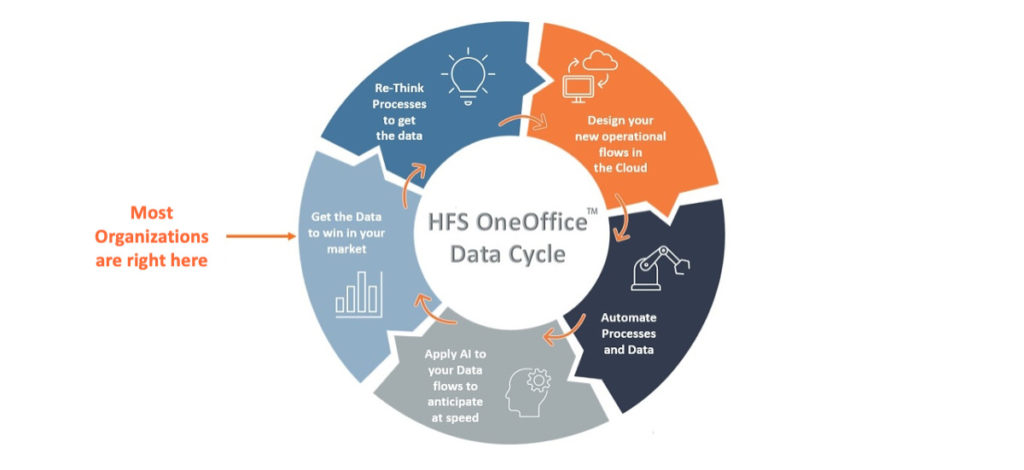Robotic process automation (RPA) emerged in the early 2010s as a threat to traditional low-cost automation. Since then, RPA initiatives in global businesses have focused on process improvement and cost take-out as critical criteria for operations improvement. With the pandemic outbreak in 2020, enterprises realized that process automation, artificial intelligence (AI), and analytics would play essential roles in their survival. As a result, they plan to increase their investments in these areas. In 2020, HFS and Blue Prism partnered to survey 400 automation leaders across the Global 2000 enterprises to understand trends in adopting automation and related technologies. To complement the study, HFS conducted a webinar with leaders from Blue Prism and Thames Water to discuss automation’s role in the future, the challenges in driving NATIVE (necessary automation technologies integrated very quickly) automation, the role of data, and the required skill set for achieving success in automation programs.
Our study results confirmed what we’ve been witnessing first-hand: COVID-19 accelerated digital initiatives across global enterprises. Global business leaders realize that using cheaper, faster, and easier means to achieve their digital transformation goals is critical to survive and thrive in the future. Additionally, customer experience, employee experience, and supplier experience have become essential for enterprises operating in an interconnected ecosystem.
“There have been a lot of COVID-19 response success stories that I have heard. I have been personally involved in some of them. COVID-19 has definitely shone the light on the value of improving the experience that comes along with the human touch while providing services to the customers.”
—Nicola North, RPA Lead, Thames Water
As shown in Exhibit 1, over 60% of the businesses worldwide have accelerated technology decision cycles due to the impact of COVID-19.

Sample: 400 executives in Global 2000 enterprises
Source: HFS Research in partnership with Blue Prism, 2020
Gone are the days when businesses viewed RPA as a tool that only helped reduce operational expenditures (OPEX). Instead, businesses now see RPA as an enabler that can help with revenue-generation strategies, manifesting in improving customer and employee experiences.
“Automation is no longer looked at as a tactical enabler for process efficiencies. Instead, businesses have started considering automation as an enabler of their growth strategies, which strongly ties to their strategic areas. How do I improve my product portfolio? How can I increase or decrease my capital allocation in certain areas as part of the investments towards growth strategies? These are some interesting CXO level conversations that are happening today to leverage automation.”
—Eric Tyree, Head of AI, Blue Prism
For example, with the increasing need to reassure customers about some aspects of services, digital contact solutions with personalized experiences will significantly improve the customer and employee experience while handling customer queries. As shown in Exhibit 2, improving the customer experience, employee experience, and supplier experience are among the top-ranked priorities for business services deployments across global firms.

Sample: 801 Global 2000 enterprises
Source: HFS Research, 2021 Pulse survey
Data transformation as a standalone strategy gains prominence when it can help companies achieve their growth strategies. Data empowers organizations’ leaders to make smarter business decisions. Moreover, data-driven strategy helps companies fully leverage the combined potential of technologies such as automation, AI, and analytics. Applying the automation lens to the overall data-driven strategy helps organizations understand the processes that need attention as part of their digital transformation journey. Consequently, this drives enterprises to seamless operations across front-, middle-, and back-office operations without barriers—what we call the OneOffice experience. As Exhibit 3 shows, organizations need to take advantage of data in combination with necessary technologies to pivot structured automation programs for achieving a OneOffice mindset.

Source: HFS Research, 2021
There are two dimensions enterprises must consider when discussing automation programs. The first one relates to empowering the digital workforce to handle the complexities of automation, interactions with internal teams and customers, languages, and processing capabilities that come with AI and analytics. The second one refers to the confluence of necessary technologies that work with the underlying systems and people in the organization. To drive NATIVE (necessary automation technologies integrated very easily), businesses should run an overarching change management program that helps infuse the mindset of embracing new technologies and developing a digital skillset. Unless this change happens, companies will fail to take advantage of NATIVE automation as enablers for their business growth strategies.
“It has been great to see how RPA has evolved over the years. We need to see how much people can push the envelope to leverage automation, related technologies, and digital skills to ensure growth for businesses.”
—Nicola North, RPA Lead, Thames Water
Register now for immediate access of HFS' research, data and forward looking trends.
Get StartedIf you don't have an account, Register here |
Register now for immediate access of HFS' research, data and forward looking trends.
Get Started